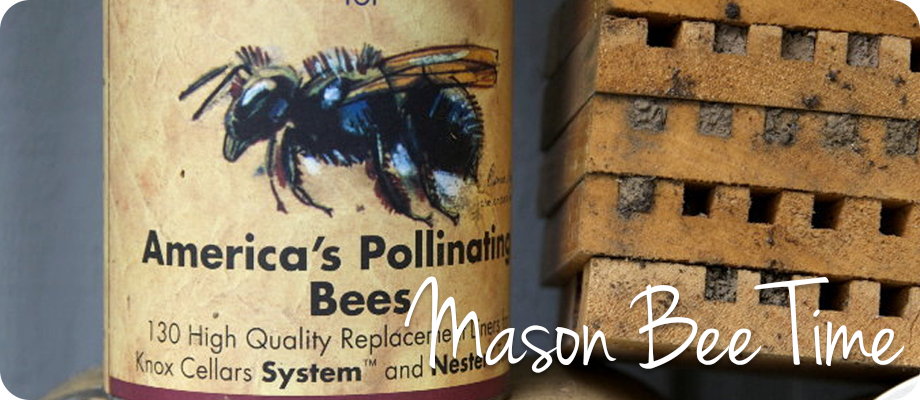We have had some beautiful spring days….. Oh, wait a minute, it isn’t spring, it’s only February. I’ve been busy pruning my apple trees (severely) and watching the buds swell. The rest of the nation is covered in white and we are having 60 degrees and sun. No real accumulation of snow in the mountains probably means water shortages in the summer (all part of climate change I think). But I’m getting off track a little.
Mason bees, yes!
Very important pollinators of the fruit trees on my property and surrounding plants. Last fall I said I was going to get bees this spring and I am getting ready to bring them home. When I told Kristen I was getting bees this spring she thought honey bees for honey and wax. But that wasn’t what I was planning on getting. I’m getting Mason Bees. No honey, no wax just fantastic little pollinators that don’t need a lot of vigilant care.
There are a number of bees, called mason bees, that are very good at pollinating fruit trees, so much so that they are also known as orchard bees. Mason bees (members of the genus Osmia) carry pollen on their bellies rather than on their hind legs and they nest in holes. When building their nests, mason bees use clay to make partitions, or cells, for their eggs and to seal the entrance once the hole is full. This unique mud-building behavior leads to their common designation as masons.
Honeybees are very important to commercial agriculture, but native bees like the blue orchard bees are better and more efficient pollinators of native crops. There are 140 species of Osmia in North America. They are all known for visiting fruit trees, such as apples, plums, pears, almonds, and peaches along with any other flowers or veg that is nearby. The blue orchard bee or Osmia lignaria, is prized for its efficiency pollinating fruit trees and is one of the few native pollinators that is managed in agriculture.
Blue orchard bees are about the same size as a honeybee but there are a few key points that help you tell them apart. Blue orchard bees are a dark metallic blue, not striped brown and orange like the honeybee. If you pay attention to where they carry their pollen you can also easily tell apart masons and other leaf cutters from honeybees – honeybees carry round balls of pollen on their hind legs.
Masons are solitary like most native bees. This means that each one tends to its own brood, instead of having a queen and worker bees. However, they seem to like the company of others of their kind and happily build their nests next to each other. They also readily accept the hollow tubes provided by the orchard grower for this purpose. This proves to be very beneficial to the fruit tree grower because it makes it easy to manage this valuable orchard helper.
We, as home gardeners, also have the opportunity to have some orchard bees in our own gardens by placing hand-made or store-bought bee houses or bee blocks in our yards. These gentle bees rarely sting and if they do it is only in defense. The sting is hardly noticeable like a mosquito bite. Great for getting kids interested in watching pollinators.
The blue orchard bee season is early spring. Once they emerge they promptly mate, search for empty holes that are the right size and shape and go to work stocking their nests. The favorite food for their brood is fruit tree pollen plus some of their nectar. Females collect this food, bring it to their nests, and knead it into a ball, mixing it with nectar and their own saliva. Once they have a food store that is big enough, they lay an egg on top of this mass and seal-off the chamber with a little mud wall and start gathering food for the subsequent cell. They work this way until there are five to eight cells each with food and one egg. Then, they seal the entrance to the hole with a thicker mud wall. The larvae grow and, by the end of summer, metamorphose into pupae and later on into adults, which remain safe and sound inside the nest until the next spring. The new generation emerges the next spring usually in perfect timing with the blooming peach or apple trees.
A quick fact – the first brood cells that the orchard bee makes (those that are furthest back) will develop into female bees, while the ones closer to the entrance of the nest will become males. Scientists believe that bees do this for one of two reasons. Males need to emerge first so that they wait for new females during mating season – putting them closer to the entrance helps them emerge first. Bees also suffer nest predation, and the brood closer to the entrance would be predated first. I think it is interesting that females are much more important to the reproduction of a species than males are. Putting the males as a barrier increases the survival and fitness of the species.
I am picking up my bee houses this weekend and will post about building the houses when I get them finished. My bees will come in later when true spring arrives. In the meantime take a look at the Growing a Greener World episode about Dave Hunter, owner of Crown Bees in Woodinville, and his Mason Bee crusade.




